American News
Jeremy Bowen: No sign of a quick peace dividend for Trump in Ukraine
At vero eos et accusamus et iusto odio dignissimos ducimus qui blanditiis praesentium voluptatum deleniti.

The Russians and Americans are talking again, as European leaders and diplomats contemplate the hard choices forced on them by US President Donald Trump.
Without question, Trump’s diplomatic ultimatum to Ukraine and America’s Western European allies has cracked the transatlantic alliance, perhaps beyond repair.
Ukrainian President Volodymyr Zelensky looks rattled by the abrupt change of attitude coming from the White House, though some of his many critics at home say he should have seen it coming. Well before he won re-election, Donald Trump made it clear that he was not going to continue Joe Biden’s policies.
As he arrived in Turkey on his latest trip, Zelensky deplored the fact that negotiations to end the war were happening “behind the back of key parties affected by the consequences of Russian aggression”.
But it feels like a long way from the air-conditioned room in Saudi Arabia where the Russian and American delegations faced each other across a broad and highly polished mahogany table, to the bitter cold of north-eastern Ukraine.
In dug-outs and military bases here in the snow-bound villages and forests on the border with Russia, Ukrainian soldiers are getting on with business as usual – fighting the war.
In an underground bunker at a base in the forest somewhere near Sumy, a Ukrainian officer told me he didn’t have much time to follow the news. As far as he was concerned, Donald Trump’s decision to talk to Russia’s president Vladimir Putin was “just noise”.
The commander, who asked to be referred to only by his call sign “White” has more pressing matters to consider.
Ignoring the diplomatic bombshell that has rattled Western leaders, as well as his own president, is probably the right thing to do for a battlefield officer preparing to lead his men back into the fight. Soon they will cross back into Kursk, to rejoin the fight to keep the land Ukraine has seized from Russia.
As a condition of access to Ukrainian soldiers, we agreed not to disclose precise locations or identities, except to say they are in the borderlands around the town of Sumy, and all part of Ukraine’s continuing fight in Kursk.
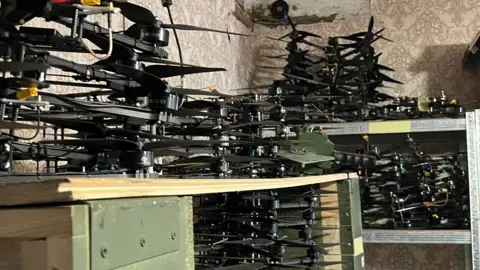
In a small room in a workshop tucked away in a village there was a formidable display of killing power on shelves made of planks from the sawmill propped up by wooden ammunition boxes.
On the shelves were hundreds of drones, all made in Ukraine. Each one costs around £300 ($380). The soldiers who were checking them before packing them into cardboard boxes to send them into the Kursk battlefields said that when they are armed – and flown by a skilled pilot – they could even destroy a tank.
One of them, called Andrew, was a drone pilot until his leg was blown off. He said he hadn’t thought too hard about what had been said far from here by the Americans – but none of them trusted President Vladimir Putin.
Their drones a few hours earlier had destroyed a Russian armoured unit advancing in broad daylight across a frozen snow-covered field. They showed us the video. Some of the vehicles they hit were flying the red banner of the Soviet Union instead of the Russian flag.
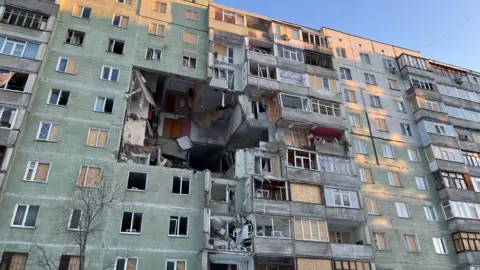
Sumy is busy enough during the day, with shops open and well-stocked. But once it gets dark the streets are almost deserted. Air raid alerts come frequently.
Anti-aircraft guns fire tracer into the sky for hours, aimed at the waves of Russian drones that cross the border near here to attack targets much deeper inside Ukraine – and sometimes in Sumy itself.
A big block of flats has a hole three storeys high ripped out of it. Eleven people were killed here in a Russian drone attack a fortnight or so ago. Since then, the block has been evacuated as engineers fear it is so badly damaged it might collapse.
It is part of a housing estate of identical monumental blocks built during the Soviet era. Residents still living next to the wrecked and unsafe building were going about their business, walking to the shops or their cars, swaddled against the intense cold.
Mykola, a man of 50, stopped to talk as he was walking home with his young son. He lives in the next block to the one the Russians destroyed.
I asked him what he thought of Donald Trump’s idea of peace in Ukraine.
“We need peace,” he said. “It’s necessary because there is no point in war. War doesn’t lead to anything. If you look at how much territory Russia has occupied so far, for the Russians to eventually get to Kyiv, they’ll have to keep fighting for 14 years. It’s only the people who are suffering. It needs to end.”
But no deal worth having, Mykola believed, would emerge from Putin and Trump sitting together without Zelensky and the Europeans.
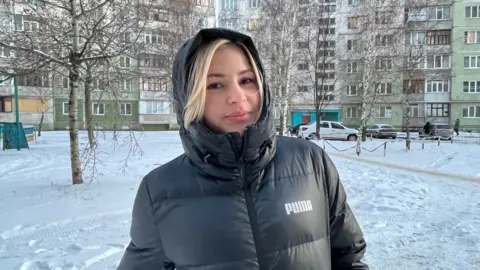
Yuliia, 33, another neighbour, was out walking her Jack Russell. She was at home when the Russians attacked the block of flats next door.
“It all happened just past midnight, when we were about to go to bed. We heard a loud explosion, and we saw a massive red flash through our window. We saw this horror. It was very scary.
“Many people were outside. And I remember there was a woman hanging out – she was screaming for help – we couldn’t see her immediately but eventually she was saved from the debris.”
Peace is possible, she believes, “but they need to stop bombing us first. There can only be peace when they stop doing that. It needs to come from their side because they started this horror.
“Of course, you can’t trust Putin.”
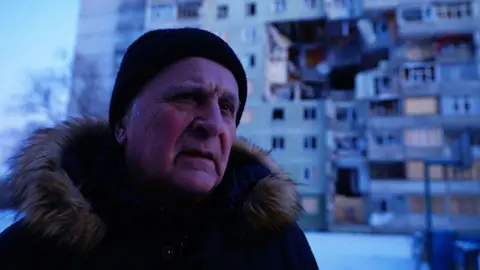
As the last rays of the sun disappeared, Borys, a spry and upright retired colonel of 70 who served 30 years in the Soviet army stopped on his way to his car. His son and grandson, he said, are both in uniform fighting for Ukraine.
“Peace is possible,” he said. “But I don’t really believe in it. I think that justice will prevail for Ukraine. You have to be cautious.
“While Putin is there, you cannot trust Russians. Because they believe in him as if he is a religion. You won’t change them. It needs time.”
So what’s the answer – keep fighting or a peace deal?
“Ukraine needs to think about peace. But we shouldn’t surrender. I don’t see any point. We will resist until we are stronger. Europe seems like they are ready to help us. There is just no point in surrendering.”
Donald Trump, a man who seems convinced that the principles of a real-estate deal can be applied to ending a war will discover that making peace is much more complicated than just getting a ceasefire and deciding how much land each side keeps.
President Putin has made very clear that he wants to break Ukraine’s sovereignty and destroy its ability to act as an independent nation.
Whether or not Ukraine’s President Zelensky has a seat at President Trump’s conference table, he won’t agree to that. Making a peace that lasts, if it’s possible, will be a long and slow process.
If Donald Trump wants a quick peace dividend, he should look elsewhere.
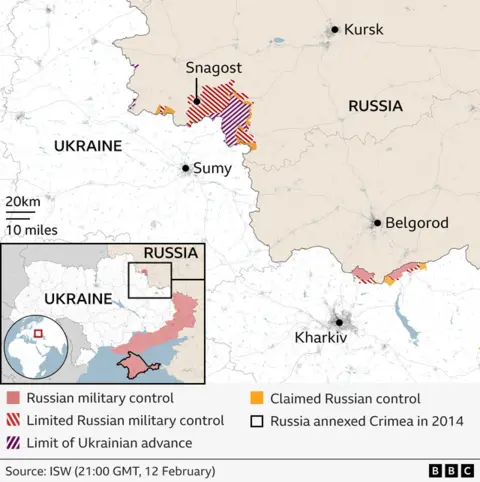
Taken From BBC News
American News
Trump rolls back tariffs on dozens of food products

US President Donald Trump has signed an executive order allowing a range of food products, including coffee, bananas and beef, to escape his sweeping tariffs.
The move comes as his administration faces mounting pressure over rising prices. While Trump previously downplayed concerns about the cost of living, he has focused on the issue since his Republican Party’s poor performance in last week’s elections.
The dozens of products included on the White House’s list of exemptions range from avocados and tomatoes to coconuts and mangoes.
These goods, the Trump administration said on Friday, cannot be produced in sufficient quantities domestically.
Trump has long said that his tariffs – currently a baseline 10% on imports from all countries, with additional levies on many trading partners – would not lead to increased prices for US consumers. He also said affordability was a “new word” and a “con job” by Democrats.
He has argued the taxes are necessary to reduce the US trade deficit – the gap between the value of goods it buys from other countries and those it sells to them. Trump has said the US has been exploited by “cheaters” and “pillaged” by foreigners, adding that higher levies would encourage those in the US to buy American goods instead.
But grocery costs and the soaring price of beef has become a political issue for Trump. Last week, he called for an investigation into the meat-packing industry, accusing companies of “Illicit Collusion, Price Fixing, and Price Manipulation”.
He has aimed to rally support for the taxes, offering $2,000 tariff rebate cheques to Americans – even as the US Supreme Court is currently weighing whether Trump had the legal authority to implement them.
But the latest exemptions signal a reversal by the Trump administration, as the White House seeks to lower prices by walking back levies on some food staples.
Speaking to reporters on Friday, Trump said the decision will affect products that are not produced in the US, “so there’s no protection of our industries, or our food products”.
He added that he doesn’t think more policy rollbacks will be required in the future, saying “I don’t think it’ll be necessary.”
“We just did a little bit of a rollback on some foods, like coffee as an example, where the prices of coffee were a little bit high. Now they’ll be on the low side in a very short period of time,” Trump said.
Economists have warned that companies would pass the cost of tariffs onto their customers in the form of higher prices.
While inflation remained milder than many analysts had expected in September, most items tracked in the Department of Labor inflation report showed price increases, with groceries up 2.7% from last year.
The Trump administration’s new tariff exemptions for food products take effect retroactively at midnight on Thursday 13 November, the White House said.
In another move to address concerns among consumers about grocery prices, the Trump administration said import taxes on coffee and bananas will be lowered as part of trade deals with four Latin American countries.
This week, Trump and Treasury Secretary Scott Bessent both vowed to decrease coffee prices by 20% in the US this year.
What items are no longer subject to tariffs?
The White House released a list that includes more than 100 products no longer subject to the levies. Some of them include:
- Coffee
- Cocoa
- Black tea
- Green tea
- Vanilla beans
- Beef products, including high-quality cuts, bone-in and boneless cuts, corned beef, some frozen items, as well as salted, brined, dried or smoked meat
- Fruits, including acai, avocadoes, bananas, coconuts, guavas, limes, oranges, mangoes, plantains, pineapples, various peppers and tomatoes
- Spices, including allspice, bay leaves, cardamom, cinnamon, cloves, coriander seeds, cumin seeds, curry, dill fennel seeds, ginger, mace, nutmeg, oregano, paprika, saffron and turmeric
- Nuts, grains, roots and seeds, such as barley, Brazil nuts, capers, cashews, chestnuts, macadamia nuts, miso, palm hearts, pine nuts, poppy seeds, tapioca, taro and water chestnuts
American News
Trump’s Empty Seat at COP30 Signals a Global Turning Point

Paris (Imran Y. CHOUDHRY) :- Former Press Secretary to the President, Former Press Minister to the Embassy of Pakistan to France, Former MD, SRBC Mr. Qamar Bashir analysis : The absence of President Donald Trump from the COP30 Climate Summit, held from November 6–17, 2025 in Belém, Brazil, was more than a diplomatic misstep; it was a disgraceful abandonment of global responsibility. This was openly acknowledged by Democratic leaders in Washington, who described the empty American chair as “a historic humiliation for the United States.” At a press conference held on the same day the summit opened, leaders lamented that America had “vacated its seat at the head table,” leaving the world’s most important climate forum without the presence of the leader of the world’s largest historical emitter. Trump’s decision to abstain, and to send only a symbolic understaffed delegation, reflected not merely neglect but a deeper, dangerous rejection of science, consensus, and global leadership.
This matters even more because the 2025 COP30 summit is one of the most consequential climate gatherings since the Paris Agreement, attended by a constellation of world leaders who are shaping humanity’s environmental future. The summit was inaugurated by Brazil’s President Luiz Inácio Lula da Silva, joined by UN Secretary-General António Guterres, Chinese President Xi Jinping, French President Emmanuel Macron, German Chancellor Olaf Scholz, UK Prime Minister Keir Starmer, Canadian Prime Minister Justin Trudeau, European Commission President Ursula von der Leyen, and leaders of almost every major African, Asian, and Latin American nation. Their presence underscored the urgency of the moment. The only notable absentee was Donald Trump.
Trump’s worldview on climate change remains skewed, unscientific, and rooted in denial. He has repeatedly dismissed climate science as “nonsense,” called global warming a “hoax,” and ridiculed decades of research produced by NASA, NOAA, the IPCC, and America’s own Department of Defense. His administration has reversed environmental regulations faster than any in modern history, rolling back more than 125 climate and pollution safeguards, reopening federal lands for oil and gas drilling, dismantling the Clean Power Plan, slashing environmental budgets, and restricting renewable energy incentives. The result is a United States stepping backward while the rest of the world steps forward.
His absence is especially alarming because the climate crisis is intensifying far faster than predictions. The world is now 1.3°C warmer than pre-industrial levels. Sea levels are rising at 4.5 millimeters per year, twice the pace of the 1990s. Extreme weather killed more than 60,000 people in 2024, with devastating storms, heatwaves, wildfires, and catastrophic floods striking every continent. Cities like Miami, New Orleans, Jakarta, and Lagos face annual flooding. Air pollution kills 7 million people annually, according to WHO. And the ozone layer, though recovering, is still vulnerable due to rising emissions of unregulated industrial chemicals.
Yet Trump chose to skip COP30 at the very moment when world leaders were committing unprecedented political and financial capital to reverse global warming. Nearly 190 countries reaffirmed climate change as “an existential threat to humanity,” agreeing to accelerate decarbonization, build climate-resilient infrastructure, and expand climate financing. China, which Trump falsely accuses of “polluting the world,” arrived with the strongest national plan: expanding renewable capacity to 5,000 gigawatts by 2030, investing $900 billion in green technologies, and pledging a national carbon peak before 2030 and neutrality by 2060. Ironically, the very nation he blames is now leading the world.
Europe also demonstrated unprecedented unity. The European Union declared climate change “the defining security challenge of the 21st century” and reaffirmed its €1 trillion Green Deal roadmap. Germany committed to shutting all remaining coal plants by 2030. France announced a massive nuclear and solar expansion. The UK pledged rapid EV adoption, banning new combustion engines by 2032. Canada committed billions to green hydrogen and Arctic protection. The contrast is stark: the world sees climate change as a war for human survival; the United States, under Trump, is withdrawing from the battlefield.
America’s withdrawal is part of a broader trend: the retreat of U.S. leadership across global institutions. The same pattern has occurred at the WHO, UNESCO, UNHRC, and WTO, where American influence has diminished due to policies seen as negative, confrontational, or aligned with narrow private interests instead of global well-being. Washington is increasingly outvoted, sidelined, or isolated—not because America lacks power, but because it has chosen to apply that power in ways that contradict scientific consensus and international expectations.
Trump continues to push policies that drag America further backward. He reopened federal financing for coal plants, issued more than 2,500 new oil and gas permits, expanded offshore drilling, and encouraged combustion-engine production while discouraging electric vehicles. He weakened fuel-efficiency standards, cut EV tax credits, and raised tariffs on imported electric cars. While China will sell over 11 million EVs in 2025, the United States faces stagnation due to inconsistent policy.
Meanwhile, renewable energy has become the cheapest electricity source in history: solar costs have fallen 89% in a decade, and wind by 70%. The world now installs 400 gigawatts of solar power annually, more than all U.S. coal capacity combined. Within a decade, fossil fuels will be economically obsolete. If America delays any longer, it will re-enter the clean energy race as a beginner—untrained, unprepared, and uncompetitive.
Inside the United States, powerful voices are rising in protest. Scientists, environmental organizations, governors, mayors, universities, and corporate leaders have condemned the administration’s retreat. California, New York, Michigan, Illinois, and more than 200 American cities reaffirmed their commitment to the Paris Agreement. At COP30, multiple senators openly declared that Trump’s absence “damages U.S. credibility and weakens national security.” Photos of the empty U.S. seat in the main plenary hall went viral worldwide, symbolizing a superpower turning its back on humanity.
America once led the world in environmental policy. It shaped the Paris Agreement, built climate finance structures, and pushed global emissions reduction. That legacy is being dismantled. Trump’s policies not only endanger the U.S. but threaten global stability. A superpower that once led from the front is now missing at the moment of greatest need.
The United States must rethink its direction before it is too late. It must return to clean energy innovation, rebuild institutional capacity, train its workforce for the green economy, and reclaim its leadership at COP and across all UN bodies. Leadership lost today will not be easily regained. The world is moving forward at high speed, and America cannot afford to be left behind again.
American News
Trump celebrates as Democrats face fallout from end of shutdown

After 43 days, the longest US government shutdown in history is coming to an end.
Federal workers will start receiving pay again. National Parks will reopen. Government services that had been curtailed or suspended entirely will resume. Air travel, which had become a nightmare for many Americans, will return to being merely frustrating.
After the dust settles and the ink from President Donald Trump’s signature on the funding bill dries, what has this record-setting shutdown accomplished? And what has it cost?
Senate Democrats, through their use of the parliamentary filibuster, were able to trigger the shutdown despite being a minority in the chamber by refusing to go along with a Republican measure to temporarily fund the government.
They drew a line in the sand, demanding that the Republicans agree to extend health insurance subsidies for low-income Americans that are set to expire at the end of the year.
When a handful of Democrats broke ranks to vote to reopen the government on Sunday, they received next to nothing in return – a promise of a vote in the Senate on the subsidies, but no guarantees of Republican support or even a necessary vote in the House of Representatives.
Since then, members of the party’s left flank have been furious.
They’ve accused Senate Democratic leader Chuck Schumer – who didn’t vote for the funding bill – of being secretly complicit in the reopening plan or simply incompetent. They’ve felt like their party folded even after off-year election success showed they had the upper hand. They feared that the shutdown sacrifices had been for nothing.
Even more mainstream Democrats, like California’s Governor Gavin Newsom, called the shutdown deal “pathetic” and a “surrender”.
“I’m not coming in to punch anybody in the face,” he told the Associated Press, “but I’m not pleased that, in the face of this invasive species that is Donald Trump, who’s completely changed the rules of the game, that we’re still playing by the old rules of the game.”
Newsom has 2028 presidential ambitions and can be a good barometer for the mood of the party. He was a loyal supporter of Joe Biden who turned out to defend the then-president even after his disastrous June debate performance against Trump.
If he is running for the pitchforks, it’s not a good sign for Democratic leaders.
For Trump, in the days since the Senate deadlock broke on Sunday, his mood has gone from cautious optimism to celebration.
On Tuesday, he congratulated congressional Republicans and called the vote to reopen the government “a very big victory”.
“We’re opening up our country,” he said at a Veteran’s Day commemoration at Arlington Cemetery. “It should have never been closed.”
Trump, perhaps sensing the Democratic anger toward Schumer, joined the pile-on during a Fox News interview on Monday night.
“He thought he could break the Republican Party, and the Republicans broke him,” Trump said of the Senate Democrat.
Although there were times when Trump appeared to be buckling – last week he berated Senate Republicans for refusing to scrap the filibuster to reopen the government – he ultimately emerged from the shutdown having made little in the way of substantive concessions.
While his poll numbers have declined over the last 40 days, there’s still a year before Republicans have to face voters in the midterms. And, barring some kind of constitutional rewrite, Trump never has to worry about standing for election again.
With the end of the shutdown, Congress will get back to its regularly scheduled programming. Although the House of Representatives has effectively been on ice for more than a month, Republicans still hope they can pass some substantive legislation before next year’s election cycle kicks in.
While several government departments will be funded until September in the shutdown-ending agreement, Congress will have to approve spending for the rest of the government by the end of January to avoid another shutdown.
Democrats, licking their wounds, may be hankering for another chance to fight.
Meanwhile, the issue they fought over – healthcare subsidies – could become a pressing concern for tens of millions of Americans who will see their insurance costs double or triple at the end of the year. Republicans ignore addressing such voter pain at their own political peril.
And that isn’t the only peril facing Trump and the Republicans. A day that was supposed to be highlighted by the House government-funding vote was spent dwelling on the latest revelations surrounding the late convicted sex offender Jeffrey Epstein.
Later on Wednesday, Congresswoman Adelita Grijalva was sworn in to her congressional seat and became the 218th and final signatory on a petition that will force the House of Representatives to hold a vote ordering the justice department to release all its files on the Epstein case.
It was enough to prompt Trump to complain, on his Truth Social website, that his government-funding success was being eclipsed.
“The Democrats are trying to bring up the Jeffrey Epstein Hoax again because they’ll do anything at all to deflect on how badly they’ve done on the Shutdown, and so many other subjects,” he wrote.
It was all a very clear reminder that the best-laid plans and political strategies can be derailed in a flash.
-

 Europe News9 months ago
Europe News9 months agoChaos and unproven theories surround Tates’ release from Romania
-

 American News9 months ago
American News9 months agoTrump Expels Zelensky from the White House
-

 American News9 months ago
American News9 months agoTrump expands exemptions from Canada and Mexico tariffs
-

 American News9 months ago
American News9 months agoZelensky bruised but upbeat after diplomatic whirlwind
-

 Art & Culture9 months ago
Art & Culture9 months agoThe Indian film showing the bride’s ‘humiliation’ in arranged marriage
-

 Art & Culture9 months ago
Art & Culture9 months agoInternational Agriculture Exhibition held in Paris
-

 Pakistan News5 months ago
Pakistan News5 months agoComprehensive Analysis Report-The Faranian National Conference on Maritime Affairs-By Kashif Firaz Ahmed
-

 Politics9 months ago
Politics9 months agoUS cuts send South Africa’s HIV treatment ‘off a cliff’


















